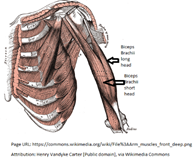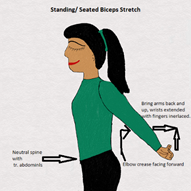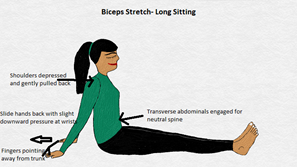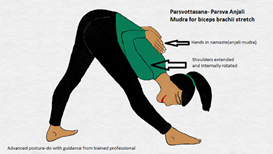|
The biceps muscle is located in the front of the upper arm. It is the muscle that pops up when you flex your arm at the elbow- yeah, that one, that is used to display strength. Since the muscle fibers in this muscle are long and parallel, contracting them causes the biceps “bulge.” This muscle can be trained and hypertrophies significantly since the myofibrils which make up muscle cells enlarge due to increase in size and amount of the composing contractile proteins.
The biceps consists of the long head and the short head. The long head is intra-articular, that is it originates inside the capsule of the shoulder joint from the supra-glenoid tubercle of the scapula. The short head originates from the coracoid process of the scapula and is extra-articular (outside the shoulder joint). Both the heads meet to form a common tendon which inserts to the proximal radius. This muscle flexes the elbow and supinates the forearm and since it passes the shoulder joint, it contributes to flexion and abduction (when humerus is externally rotated) and horizontal adduction (when humerus is medially rotated) of shoulder joint. It is the main muscle enabling carrying of load in hands with the palm facing upwards (supinated forearm). Here are the various ways to stretch the biceps brachii. For ease of understanding, and consistency, description is for right sided stretch. Passive Stretch This is done by various manual techniques based on the examination of the shoulder joint and shoulder girdle. The trigger points maybe located in the muscle belly (front middle of upper arm), the upper back, the lateral shoulder joint, or down the front of upper arm towards the elbow joint. Myofascial release and transverse friction by a trained therapist to release proximal tendon of long head of biceps in the bicipital groove, improves the ROM. Beginning from a good upright seated posture with neutral spine and feet supported on the floor, the therapist may also passively stretch the biceps by externally rotating the shoulder so that the elbow crease is facing forward and extending the shoulder behind the back. Wrist extension further stretches the biceps via the distal insertion of this muscle. Active Stretch i) The easiest stretch in acute phase is done in supine with the arms resting by the side on the mat, palms facing up. Place a towel roll under the right upper arm and slowly extend the arm at the elbow joint so that the right wrist is extended and off the edge of the mat with gravity assisting elbow extension. Hold the position for 5-30 seconds as stretch is experienced in the front of upper arm. Repeat 2-3 times with rest breaks in between. ii) The stretch may be done standing with feet shoulder width apart and facing forward. The hands are clasped behind the back by interlocking fingers and turning the arm so that palms face down. Engage the transverse abdominals and hold spine neutral while slowly elevating the arms away from the back. Ensure the chest is open and shoulders pulled back with trunk upright. Hold when stretch is felt in the front of shoulder, upper arm for 5-30 seconds. Release and rest for the same time as the stretch is held. Repeat stretch 2-3 times. iii) Long sitting position is assumed with the hands palm down and resting on the mat behind the back, and arms externally rotated so that fingers are pointing away from the body. Shoulders should be neutral or slightly depressed (gently press the wrists into the floor/mat). Now start sliding the wrists back and away from the trunk. Hold when stretch is felt in the upper arm or front of shoulder along the biceps muscle/tendon. Mild downward pressure should be maintained at the wrist throughout. To release, slide hands towards the trunk. Repeat stretch 2-3 times with rest breaks in between. iv) Parsva Anjali Mudra or in other words Namaste or hands joined as in prayer behind the back is a great way to stretch the biceps. This is done with the Parsvottanasana, which is a forward bending posture, however may be done stand-alone in an upright seated posture for upper body benefits. The key here is to keep shoulders rolled back and to open the chest while bringing the hands behind the back in prayer position. It requires maximal shoulder internal rotation with extension and is not recommended in existing rotator cuff injuries without rehabilitation and guidance. Stretch with tools and equipment i) The biceps maybe released by using a tennis ball along the front of upper arm along the length of the biceps at the wall. Since these are parallel muscle fibers, they are best stretched by lengthwise movements along the muscle fibers. When a tight trigger point is detected, small, circling, motion of the ball over the specific area may help release the local tightness.
0 Comments
Your comment will be posted after it is approved.
Leave a Reply. |
Details
AuthorAmi Gandhi is a licensed physical therapist in the state of California. She is the owner of StableMovement Physical Therapy, a small boutique practice in San Jose that offers patient centered, one-on-one, hands-on physical therapy. Archives
March 2018
Categories |



